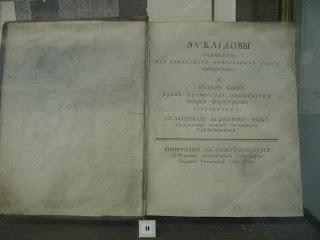First, outside the museum is the strangest statue of a nation's former leader that I have ever seen. It is supposedly Peter the Great, but it looks more like Peter the Circus Freak. Compare the size of the head to the body and the stringy fingers. It was not received by the city without criticism, unlike a more regal statue of Peter.
Let's now go inside the museum. Long before St. Petersburg was founded, the region was populated by various tribes (small circles in the picture below) and one very tall giant (in the lower right):
During the Middle Ages, battles for control of the territory were waged among the Swedes, Germans, and the Rus (precursors of the Russians). One of the early military victories of the Rus against the Swedes was led by Alexander Nevsky, who brewed a namesake beer that survives to this day. (At that beer link, you will be asked if you are over 18. Press Нет (nyet) to see where you get sent!)
Little is known about the Rus, but evidence suggests they spent their leisure time building rather impressive small-scale model forts and suspension bridges:
One of the worst crises to occur to the Rus was a disease which caused everyone to lose their eyeballs:
This made hunting more difficult.
When Peter the Great, the Russian emperor, decided to get away from Moscow in 1703 by creating a new capital city in the swamplands of northwestern Russia, the local population was very excited because Peter had impressively large eyeballs:
The fact that Peter bears a strong resemblance to Salvador Dali was a good sign for the future of artistic expression in the new city (although Peter required everyone, including himself, to cut their long moustaches, which led to some grief):
The residents of St. Petersburg produced many books in the 18th century, like a translation of Euclid's Elements
and a work called "Conversations on Spelling":
Unfortunately this book was filled with all kinds of weird or extraneous letters, so it set back progress on spelling for over 150 years.
One of the important writers in St. Petersburg during the early 19th century was Nikolai Karamzin
who all his life kept getting confused with the French mathematician Cauchy:
Did you know the first Swiss Army knife was developed in St. Petersburg?
The Russian soldiers spent too much time fiddling with this new tool instead of focusing on their military skills. The third and fourth soldiers on the right in the next picture illustrate the problem:
Because St. Petersburg is surrounded by water, it is subject to periodic floods. Here is one of the worst, from 1824:
To make sure at least part of the city would be visible under any conceivable flood, so it would not be forgotten, in 1834 the government installed a very tall column of granite. To put it in place, the column was rolled up an incline
where it still stands to this day:
The city of St. Petersburg saw steady industrial development throughout the 19th century, starting with the railroads. Here is a picture of one of the first trains trying to leave St. Petersburg in the 1830s.
Unfortunately, as you can see above, people kept standing on the tracks to get a better look at the new trains, and it was hard to clean mangled bodies out of the train wheel gears. This explains why the first train successfully left St. Petersburg and reached another city only in 1851.
One of the prominent St. Petersburg businessmen of the 19th century was the watchmaker Pavel Bure
who later joined the National Hockey League while keeping an eye on his watch store on Nevsky Prospekt:
Among the companies doing business in St. Petersburg in the second half of the 19th century and beginning of the 20th century was the Underwood typewriter company
and the Chebyshev calculator company
Despite all this progress, the old traditions of small-scale model building (remember the fort and suspension bridge?) were not forgotten. Here is part of an apartment model, with a family of cats in the attic:
This is a model of one of the St. Petersburg city squares from two different points of view:
The model builders eventually realized they could make their city scenes more realistic by putting people in them. Here are some crowds protesting various social causes:
The history museum only describes events in St. Petersburg up to the year 1917. I wonder what happened after that.































Комментариев нет:
Отправить комментарий